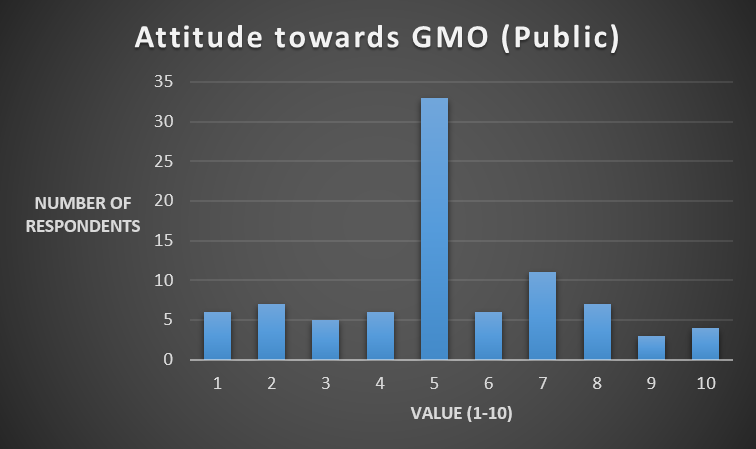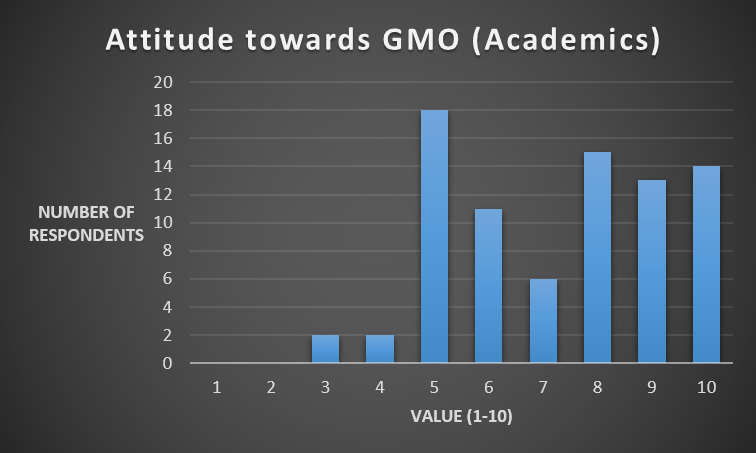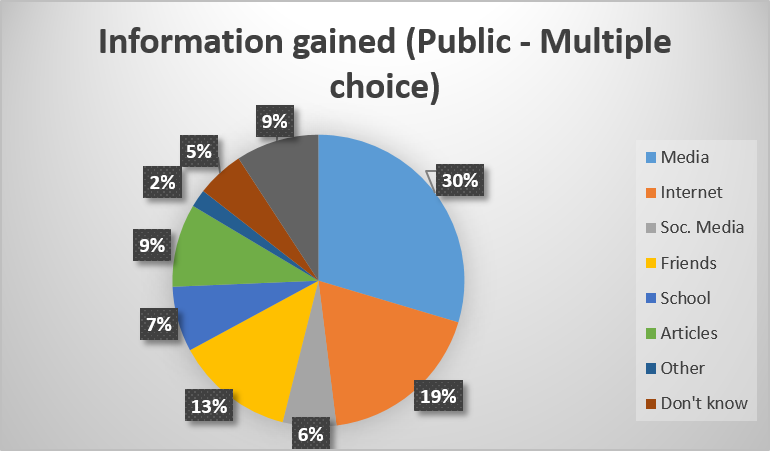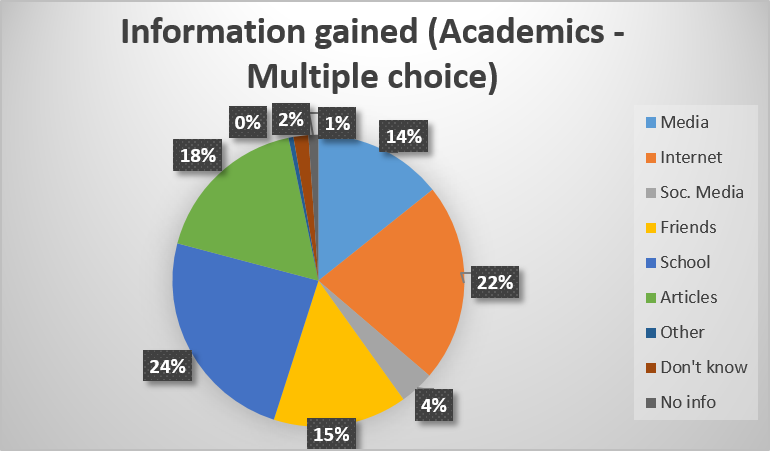Team:Chalmers-Gothenburg/Society
Society
For a bright future in the field of synthetic biology, we team Chalmers-Gothenburg, consider it to be of great importance to inform the society about the benefits of synthetic biology as well as having an open debate regarding the ethics. In a democratic society, the laws are legislated by the politicians representing the citizens. These laws control the development within the field of synthetic biology, and for people to be able to make informed political decisions, knowledge is key. As a team, we were interested in the public opinion regarding synthetic biology and genetic modification and thereby decided to conduct a survey about genetically modified organisms (GMOs) in cooperation with team Czech Republic. After finishing the survey, we also took the opportunity to inform the people about GMO and synthetic biology. To further reach out to the general public, we used the media, such as the swedish radio, magazines and social media.
Survey
In today’s society there is still controversy and some taboo regarding synthetic biology and specifically the, to the public more well-known, term GMO. Opposition is something synthetic biologists of today and of the future, many of those present at the Giant Jamboree, will continue to face. A lot of work lies ahead in order to receive more acceptence outside the scientific community.
A general feeling our team has had is that a lot of people dislike GMOs but that acceptance is slowly increasing. As for the reasons why the general public dislikes GMOs, they can be thoroughly discussed for a long time but one thing that quickly comes to mind is lack of knowledge. To get an idea where scientists stands on GMOs versus the general public, we devised a survey which was handed to both academics at Chalmers and which we asked people about in the streets of Gothenburg. In addition, we sent our survey to team Czech Republic. They also asked the public and academics at their university to answer the survey and we’ve then looked at the results to observe differences and similarities between the public in Sweden and in the Czech Republic. The results were compared in regards to education and gender as well.
The survey consisted of eleven questions. The first two questions were about gender and age and the third was about if they’d ever heard of GMOs. If the respondent’s answer here was “no” we would explain what it stood for. If they at this point did recognize GMOs we would continue. If they still didn’t recognize what GMOs were we would thank them for their time but unfortunately tell them that we could not obtain any more useful information from them. The explanation of the abbreviation was the only information we gave during the questioning in order to avoid affecting the respondent. The remaining questions consisted of some yes/no/don’t know-questions and some about their feelings towards GMO in general and the research on GMOs based on a scale from 1-10. After the respondent had answered every question we would ask them if they wanted to know more about GMO and about iGEM. To those who agreed we would talk about Golden Rice, biotechnologically produced insulin, about iGEM in general and about our project in an effort to further spread knowledge about GMOs and synthetic biology to the public.
The survey in its entirety can be seen here.
The total amount of people interviewed from the general public were 94 (44 from Sweden and 50 from the Czech Republic), however six of those from Sweden didn’t recognize the term GMO and therefore they didn’t answer any further questions. The total number of academics (biologists) were 82, 63 of whom were from the Czech Republic and 19 were from Sweden.
Overall, a few initial observations can be made. Academics have a more positive attitude towards GMOs in general than the public. Males seem to be more positive about GMOs than females when regarding the public, however even if the difference is statistically significant in total it’s only in Sweden it’s actually significant where the difference is large. The difference between genders in the Czech Republic is not significant. People from the Czech Republic are more positive about GMOs than those from Sweden (tobs=3.30 and tstat(0.05,60)=1.671 in a one-sided t-test with assumed different variance), however how we approached the respondents, where we went or even what day we went on could all affect this outcome.
Figure 1. A comparison of the results obtained regarding the respondents general feeling towards GMO. The respondent were asked to express their feeling on a scale from 1-10 were 1 relates to a very negative attitude and 10 a very positive attitude. What the general public answered can be seen on the left and what academics answered can be seen on the right. These results include both answers from Sweden and the Czech Republic.
Where people have received information from about GMO varies. Media is very prevalent in both the Swedish and the Czech answers within all ages as well as within the academic world. The internet (mostly younger people) and friends are also common answers. School and social media seem to be a more common source of information, especially for younger people, in Sweden than in the Czech Republic. Scientific articles dominates in the academic field however quite a few people in the public have also gained information about GMO from articles. While only a few (14 from the public and 2 from academics) claim to have had no information, most people of the public agree that they have not obtained enough information about GMO to really understand what it is and make rational decisions about it. Most academics claim they have obtained enough information.
Figure 2. A comparison of the results obtained regarding how the respondent had obtained information about GMO. The question was of multiple-choice character meaning each respondent could give a different amount of answers. How the general public said they had received information can be seen on the left and how academics have received information can be seen on the right. These results include both answers from Sweden and the Czech Republic.
Almost all academics knew GMO can be used in more than crops while only half of the public, both in Sweden and in the Czech Republic, knew about this. Generally, people of the public are more reluctant towards using GMOs in food and crops but more positive about using it in medicine, fuel and other materials. Both academics and the public mostly agree that it’s important to do thorough research on the effects of GMO but are a little more split on the production of new GMO-products. Although true for the whole survey, the interpretation of the question is particularly important when it comes to these two questions. Some of those who were positive about new products added something along the lines of “as long as the effects are well known and safe” and some of those against added “because we need to know they are safe and the effects are well known”. This may cause some trouble for the analysis of the results but a general feeling is that most people are okay with new GMO-products as long as they’re effects are well studied and generally regarded as safe.
What’s interesting is that most people we talked to in the street wanted to hear more about GMO and iGEM once we were done with the questions and many were positive about the new information. If they’d been positive about GMO before they naturally still seemed positive but those who were more negative seemed to open up a bit and many said they’d look up more information about GMO and synthetic biology.
To try and summarize: the public were a bit more positive about GMO than we’d have thought. Those who were against it had often heard bad things about GMO in media, from friends or just hadn’t received enough information at all. Some of those seemed to sway towards a more positive side after our conversation. This may simply be because of politeness or disinterest but we’d like to think that most people would be more positive about GMO and synthetic biology if we spread more knowledge about it and highlighted everything that’s beneficial with it while acknowledging all the research and controls that have to be made and precautions that have to be taken.
To see a spreadsheet of all the results and all statistical values click here.
This is just a beginning. It would be great if upcoming teams could expand the survey to include more participants. This would increase the statistical certainty of the survey. For instance is the difference between males and females in Sweden only significant at a 95% level but not at 99% (tobs=1.901, tstat(0.05,34)=1.696 and tstat(0.01,34)=2.453). It would also make it possible to compare results over the years and to be able to categorize the results more, even further looking at differences between ages for instance. More participants is also great for including more people from different areas with different backgrounds, making the survey even more extensive and complete. We will advise the next team Chalmers Gothenburg to continue with the survey. We want to thank team Czech Republic for participating and hopefully more teams may participate in upcoming years.
Media as a tool to reach society
We have been in contact with media for the purpose of spreading information about iGEM, Synthetic Biology and our project and team. We have reached out through the radio, newspapers and the university press. We got an interview at our local radio station (P4) at their morning program in the beginning of August. We spoke about the competition and our project idea and the program can be found by this link (the program is in Swedish): http://t.sr.se/1Pa2mVl the interview can be found from 2:39:30.
We have also been published in two different papers, Kemivärlden: Biotech which is a chemistry- and biotechnology paper and also Ingenjören which is a paper for engineers. We also got an article published at our university’s webpage for areas of advance. All of the articles gives a bit of information about the iGEM competition and about our project and the work we have been doing this year. The articles are published online at each paper’s respective website where everyone can see and read them. They are all in Swedish but can be found using the following links:
http://www.ingenjoren.se/2015/08/svenska-teknologer-tavlar-i-genteknik/
http://www.chalmers.se/sv/styrkeomraden/livsvetenskaper/nyheter/Sidor/Chalmersstudenter-deltar-i-Genetically-Engineered-Machine.aspx
We are very happy that we got the opportunity to reach out in all of these different ways and we hope the result is that more people obtain knowledge about iGEM and the area of research. By spreading the information to mainly people in the scientific and engineering field we hope to be able to establish more collaborations between iGEM teams and industries. We also wish to make people interested in our project and for them to see the potential in the final product and what the parts can be used for.
We have also been published in the paper Ingenjören witch is a paper for engineers all around Sweden and the article is posted on their webpage for everyone to see it. In the article we talk about the iGEM competition and what kind of project we are working on this year. The article is in Swedish and can be found here: http://www.ingenjoren.se/2015/08/svenska-teknologer-tavlar-i-genteknik/
The scientific paper Kemivärlden: Bioteck who focuses on chemistry and biotechnology also wrote an article about us, our project and the iGEM competition. The article can be found here: får lank runt 15/9 Last but not least we got an article published on our university’s webpage for areas of advance, life science engineering: http://www.chalmers.se/sv/styrkeomraden/livsvetenskaper/nyheter/Sidor/Chalmersstudenter-deltar-i-Genetically-Engineered-Machine.aspx



